Coarse Hair: The Complete Guide to Care, Styling, and Tips (2025)
Coarse hair is a natural hair type known for its thickness, strength, and volume. Unlike fine or medium hair, coarse strands have a larger diameter, which makes them appear fuller and more resilient. While this gives coarse hair its unique beauty, it can also be challenging to manage due to its tendency to feel rough, frizzy, or dry.
If you’ve ever wondered about the meaning of coarse hair or how to tell if your hair is coarse, this guide is for you. In this article, we’ll cover everything you need to know, including:
-
What is Coarse Hair? (key characteristics)
-
Best shampoos and conditioners for coarse hair
-
Hair care tips for men and women
-
Short haircuts and styling ideas
-
The latest trends in coarse hair care (2025)
Whether your hair is short or long, straight or curly, this guide will help you make your coarse hair healthier, shinier, and easier to style.
What to Know About Coarse Hair
What is Coarse Hair?
Thick hair, often called coarse-textured hair, is a type characterized by wider and stronger strands compared to medium or fine hair. Each strand has a larger diameter, which gives it a naturally voluminous and full-bodied look. People with this hair type may notice that their locks feel rough, wiry, or dry, especially when exposed to heat styling, harsh products, or environmental stress.
Understanding what coarse-textured hair means is essential for proper hair care, styling techniques, and maintaining healthy strands. With the right products and grooming routine, this hair type can look not only strong but also soft, shiny, and manageable.
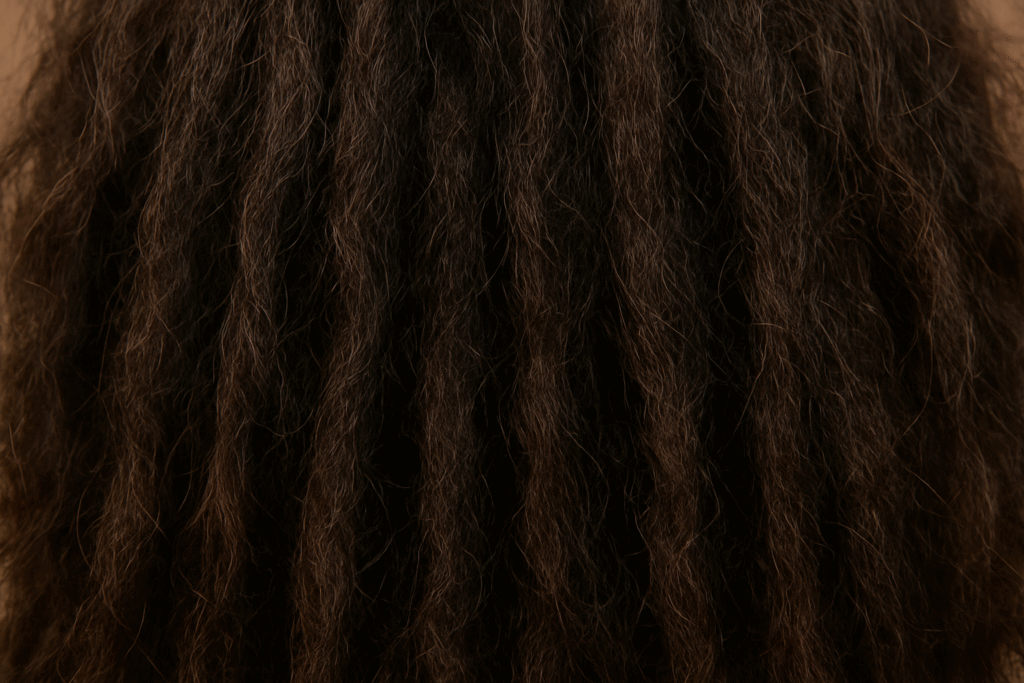
Coarse Hair Meaning
The term coarse-textured hair refers to strands with a rough texture and larger diameter compared to fine or medium hair. This type of hair is not a sign of damage; rather, it is a natural and healthy hair structure. Thanks to its thick cuticle layer, coarse or thick hair is generally stronger and less prone to breakage. However, this same structure can also make it more vulnerable to frizz, dryness, and difficulty in managing smoothness.
With the right products, hydration, and care routines, coarse-textured hair can shift from feeling wiry or unruly to becoming soft, shiny, and manageable.
Characteristics of Coarse Hair:
-
Thick Strands: Each hair strand is wider than average, giving hair a denser look.
-
Rough Texture: Coarse hair often feels coarse or wiry to touch.
-
High Volume: The hair appears naturally full and voluminous.
-
Durable: Coarse hair is strong and resistant to breakage compared to finer hair types.
-
Dryness-Prone: The thick cuticle can make it difficult for natural oils to travel along the hair shaft, causing dryness.
Fine vs Coarse Hair:
-
Fine Hair: Delicate, lightweight, soft, and may break easily.
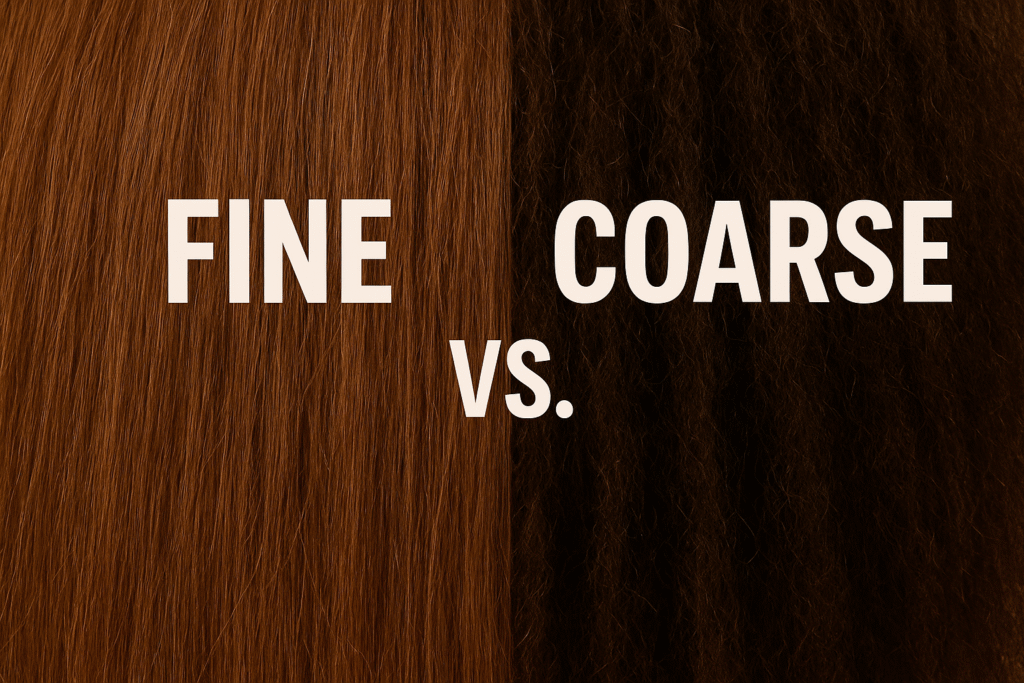
-
Coarse Hair: Thick, strong, voluminous, and resilient, but may require more care to reduce frizz and maintain moisture.
Why Knowing Your Hair Type Matters:
Recognizing that you have thick or coarse-textured hair helps you select products made specifically for this hair type. Hydrating shampoos, nourishing conditioners, deep-repair masks, and frizz-control treatments can all enhance the natural strength of your strands while keeping them smooth and manageable. In addition, choosing the right haircuts and styling methods prevents bulkiness and makes your hair easier to handle.
Tips for Managing Coarse Hair:
.
-
- Always use a moisturizing shampoo and conditioner to combat dryness
- Apply hair masks or natural oils weekly for softness.
- Limit heat styling to protect the hair shaft.
- Sleep on silk or satin pillowcases to reduce friction and breakage.
Coarse Hair in Men
Men with dense, thick hair often enjoy natural volume and strength. However, coarse-textured strands can be tricky to manage due to their rough feel, tendency to frizz, and overall density. Understanding the unique traits of this hair type is essential for proper grooming, styling, and long-term hair health.
Characteristics of Coarse Hair in Men:
-
- Thicker Strands: Wider diameter gives a fuller, voluminous look.
- Rough Texture: Often wiry or dry, especially when exposed to harsh products.
- High Density: Naturally full but harder to style without technique.
- Resistant to Breakage: Stronger than fine hair but prone to frizz or dryness.
Common Challenges Men Face:
-
Difficulty in achieving sleek or smooth hairstyles
-
Prone to dryness and split ends
-
Frizz, especially in humid climates
-
Bulky appearance if not layered or cut properly
Hair Care Tips for Men with Thick Hair:
- Use lightweight, hydrating shampoos (avoid heavy formulas that flatten hair).
- Condition regularly to soften strands and fight frizz.
- Try styling creams or pomades for control without stiffness.
- Choose alcohol-free gels and sprays to avoid dryness.
- Limit heat tools, and always use a protectant when styling.
Popular Men’s Hairstyles for Coarse Hair:
-
Short Textured Cuts: Ideal for easy maintenance and controlling bulkiness.
-
Fades with Volume on Top: Adds style and highlights the natural texture of coarse hair.
-
Messy Natural Styles: Embraces natural waves or curls for a rugged, effortless look.
-
Slicked-Back Styles: With the right hair cream or pomade, coarse hair can be styled sleekly for formal occasions.
Tips for Styling Coarse Hair in Men:
-
Layer Hair Strategically: Layers reduce weight and make thick coarse hair easier to style.
-
Use Leave-In Conditioners or Hair Oils: These help soften hair, enhance shine, and reduce frizz.
-
Embrace Natural Texture: Instead of forcing straight styles, work with the hair’s natural shape for better results.
-
Regular Trims: Every 6–8 weeks to remove split ends and maintain the desired hairstyle.
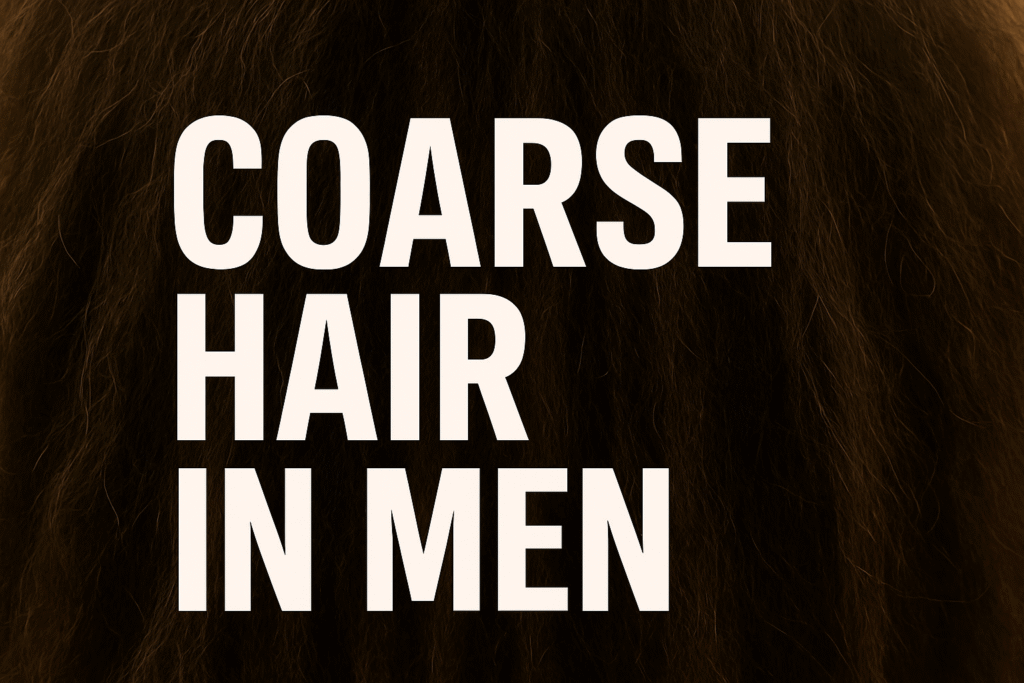
Hair Care Tips for Thick Hair
Caring for thick-textured hair requires a tailored routine because of its dense strands, natural fullness, and tendency to become dry or frizzy. Unlike fine or medium types, this hair texture needs extra hydration and gentle handling to stay healthy, shiny, and manageable. The good news? With the right products and techniques, strong, voluminous hair can look its best every day. Below are some of the most effective tips to keep rough or wiry strands soft, smooth, and full of life:
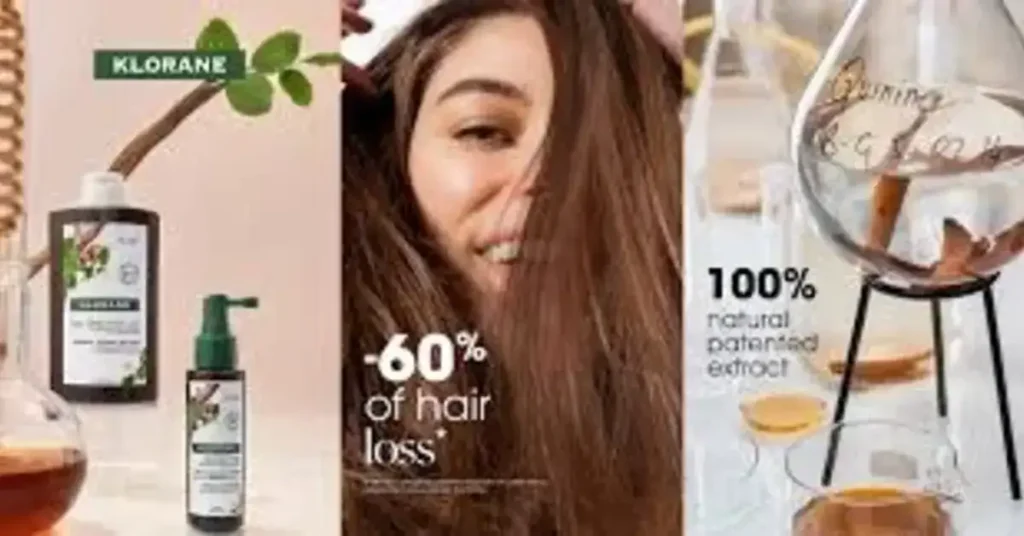
1. Use the Right Shampoo
Choosing a shampoo for coarse hair is the first step toward healthy strands. Coarse hair needs hydration and gentle cleansing, so opt for:
-
Sulfate-free shampoos: These maintain natural oils and prevent excessive dryness.
-
Moisturizing ingredients: Look for shampoos containing argan oil, coconut oil, shea butter, or aloe vera.
-
Frizz-controlling formulas: Smoothen the hair cuticle for better manageability.
Best Shampoo for Coarse Hair:
SheaMoisture Shampoo for Moisture Retention with Raw Shea Butter
- OGX Moroccan Argan Oil Shampoo
- L’Oréal Paris’s EverPure Moisture Shampoo
Using the right shampoo consistently helps coarse hair retain natural shine and softness.
2. Always Use a Conditioner
Coarse hair tends to be dry, so using a conditioner is essential. Conditioners:
-
Add more moisture and nourishment.
-
Reduce frizz and tangling
-
Make hair softer and easier to comb
Tip: Apply conditioner from mid-lengths to the ends, avoiding the scalp to prevent oiliness. For maximum benefit, use a leave-in conditioner to keep hair hydrated throughout the day.
3. Limit Heat Styling
Excessive use of straighteners, curling irons, and blow-dryers can damage coarse hair. The hair shaft is strong, but high heat can lead to dryness, frizz, and split ends.
Tip: When using heat, always apply a heat protectant spray and keep the temperature moderate.
4. Use Hair Masks Weekly
Weekly hair masks help restore moisture, reduce frizz, and improve texture. Ingredients to look for:
-
Shea butter
-
Coconut oil
-
Argan oil
-
Honey
Massage the mask from roots to tips and leave it on for at least 20–30 minutes for best results.
5. Sleep on Silk or Satin Pillowcases
Coarse hair is prone to friction damage, especially while sleeping. Silk or satin pillowcases reduce friction, preventing hair breakage, frizz, and split ends. This simple step can significantly improve hair smoothness over time.
6. Take Vitamins for Hair Health
Nutrition plays a critical role in hair care. Coarse hair benefits from vitamins and supplements that strengthen hair follicles and improve elasticity, including:
-
Biotin
-
Vitamin E
-
Omega-3 fatty acids
-
Zinc
A balanced diet rich in these nutrients supports stronger, shinier coarse hair.
7. Get Regular Trims
Regular trims every 6–8 weeks remove split ends and prevent tangling. Coarse hair grows fast and can look bulky if not trimmed strategically. Layering during trims also helps in reducing weight and improving manageability.
8. Use the Right Brush
Using the wrong brush can damage coarse hair. Opt for:
-
Combs with wide teeth for untangling damp hair
-
Boar bristle or mixed bristle brushes for distributing natural oils on dry hair
Avoid fine-tooth combs on wet hair as they can break strands and increase frizz.
9. Go Alcohol-Free
Many styling products contain alcohol, which can dry out coarse hair. Choose alcohol-free gels, mousses, and sprays to maintain hydration and hair softness.
10. Takeaway Tips for Coarse Hair Care
-
Moisturize hair daily with conditioner or leave-in cream
-
Steer clear of harsh sulfate-containing shampoos.
-
Reduce heat styling
-
Use hair masks weekly
-
Sleep on silk pillowcases
-
Take hair-supporting vitamins
-
Trim hair regularly
-
Use proper combs and brushes
-
Embrace alcohol-free styling products
Styling Thick-Textured Hair
Styling thick or full-bodied hair can sometimes be challenging because of its dense strands, natural volume, and frizz-prone nature. However, with the right techniques, products, and haircuts, this strong hair type can be transformed into stylish, manageable looks. Whether you prefer short, medium, or long styles, the secret is to embrace the hair’s natural texture instead of fighting against it.
Short Haircuts for Thick, Textured Hair
Short styles are perfect for dense, voluminous hair because they help reduce heaviness and make styling much more manageable. Popular options include:
Layered Bob
Adds natural movement while removing excess weight. Perfect for women with thick strands, as layers allow the hair to fall more smoothly without appearing bulky.
Textured Pixie Cut
A short, edgy option that works beautifully for strong, wiry hair. The added texture softens the look, reduces bulk, and enhances the hair’s natural pattern.
Shaggy Layers
Ideal for full-bodied hair, shaggy layers lighten the load while creating a soft, voluminous appearance.
Undercut
A trendy choice among men with thicker textures. The sides are kept short while leaving volume on top, making it much easier to control and style.
Fades with Natural Texture
Men can highlight their coarse, thick texture with fades—keeping the sides neat while allowing the top to showcase its natural fullness without becoming unmanageable.
FAQs
Q1: Can coarse hair become soft? Yes, with moisturizing shampoos, conditioners, and weekly hair masks.
Q2: Is coarse hair healthy? Coarse hair is naturally strong and dense. Rough texture is normal.
Q3: What is the best shampoo for coarse hair? Sulfate-free shampoos with moisturizing natural oils.
Q4: How to style short coarse hair? Layered cuts, pixie cuts, or undercuts with leave-in conditioners work best.
Q5: Difference between thick coarse hair and fine hair? Thick coarse hair has larger diameter strands and more volume; fine hair is delicate and soft.
Outlook / Latest Trends in Coarse Hair (2025)
In 2025, the world of coarse hair care and styling is experiencing a significant shift towards embracing natural textures, sustainable practices, and innovative products. Here’s an in-depth look at the latest trends shaping the coarse hair landscape this year.
1. Embracing Natural Texture
The trend of embracing natural hair textures continues to dominate in 2025. Individuals with coarse hair are opting for styles that highlight their natural volume and texture, moving away from excessive heat styling and chemical treatments. This approach not only promotes healthier hair but also celebrates the unique characteristics of coarse hair.
Key Styles:
-
Layered Bobs: Adding layers to coarse hair can reduce bulk and enhance movement, creating a more manageable and stylish look.
-
Textured Pixie Cuts: For those preferring shorter styles, textured pixie cuts offer a chic and low-maintenance option that showcases natural texture.
-
Shag Cuts: The return of shag cuts allows for a playful and voluminous appearance, ideal for coarse hair that benefits from added layers.
2. Sustainable and Clean Hair Care
Sustainability is at the forefront of hair care in 2025. More and more customers are looking for goods that are both eco-friendly and efficient. This includes:
-
Eco-Friendly Packaging: Brands are adopting biodegradable and recyclable packaging to reduce environmental impact.
-
Clean Ingredients: There’s a growing demand for hair care products free from harmful chemicals, with a focus on natural and organic ingredients that nourish coarse hair without causing damage.
-
Water-Conscious Formulas: Products designed to be effective with minimal water usage are gaining popularity, aligning with global efforts to conserve water resources.
3. Scalp Health and Personalized Care
Understanding that healthy hair starts with a healthy scalp, 2025 sees a rise in personalized hair care routines. This includes:
-
Scalp Treatments: Regular use of scalp treatments to maintain a balanced environment, promoting optimal hair growth and health.
-
Customized Hair Care Regimens: Tailored hair care routines based on individual hair types and concerns, ensuring that coarse hair receives the specific care it needs.
-
Professional Consultations: Increased consultations with hair care professionals to develop personalized plans that address unique scalp and hair needs.
4. Low-Maintenance Styling
With the fast-paced nature of modern life, low-maintenance styling has become essential. For coarse hair, this involves:
-
Heatless Styling Techniques: Utilizing methods that minimize heat exposure, such as braiding damp hair for natural waves or using curl-enhancing creams.
-
Protective Styles: Incorporating styles like braids or buns that protect the hair from environmental stressors and reduce the need for daily styling.
-
Minimalist Products: Focusing on a few high-quality products that provide multiple benefits, simplifying the hair care routine.
5. Technological Innovations in Hair Care
Advancements in technology are influencing hair care practices in 2025. Innovations include:
-
Smart Hair Tools: Devices that adjust temperature and styling techniques based on hair type, ensuring optimal results without causing damage.
-
AI-Powered Hair Analysis: Applications that analyze hair condition and recommend personalized products and routines.
-
Advanced Hair Treatments: Treatments that penetrate deeper into the hair shaft, providing nourishment and repair at a cellular level.
Takeaway
Coarse hair is naturally thick, strong, and full of volume, but it requires a specific care routine to keep it healthy, soft, and manageable. The key takeaway from this guide is that understanding your hair type and following proper hair care practices can transform coarse hair from unruly to beautifully styled.
Essential Points for Managing Coarse Hair:
-
Understand Your Hair Type: Knowing what coarse hair is and its characteristics helps in selecting the right products and routines. Coarse hair is not damaged hair—it’s simply thicker, stronger, and requires proper hydration.
-
Use Hydrating Products: Always choose shampoos, conditioners, and hair masks specifically formulated for coarse hair. Ingredients like argan oil, shea butter, coconut oil, and aloe vera help retain moisture and reduce frizz.
-
Minimize Heat Damage: Limit the use of straighteners, curling irons, and blow-dryers. When heat styling is necessary, always use a heat protectant to prevent dryness and breakage.
-
Embrace Natural Texture: Coarse hair looks best when its natural waves, curls, or volume are embraced. Styles like layered bobs, shag cuts, textured pixies, or natural tousled looks highlight the hair’s unique character.
-
Protect Hair During Sleep: Use silk or satin pillowcases to reduce friction and prevent frizz, split ends, and breakage.
-
Regular Trims and Maintenance: Trim coarse hair every 6–8 weeks to remove split ends, maintain shape, and keep hair manageable.
-
Take Care from Within: A balanced diet rich in biotin, vitamin E, omega-3 fatty acids, and zinc strengthens coarse hair and promotes healthy growth.
-
Use the Right Styling Tools: Wide-tooth combs, boar-bristle brushes, and alcohol-free styling products ensure that coarse hair stays smooth without causing damage or dryness.
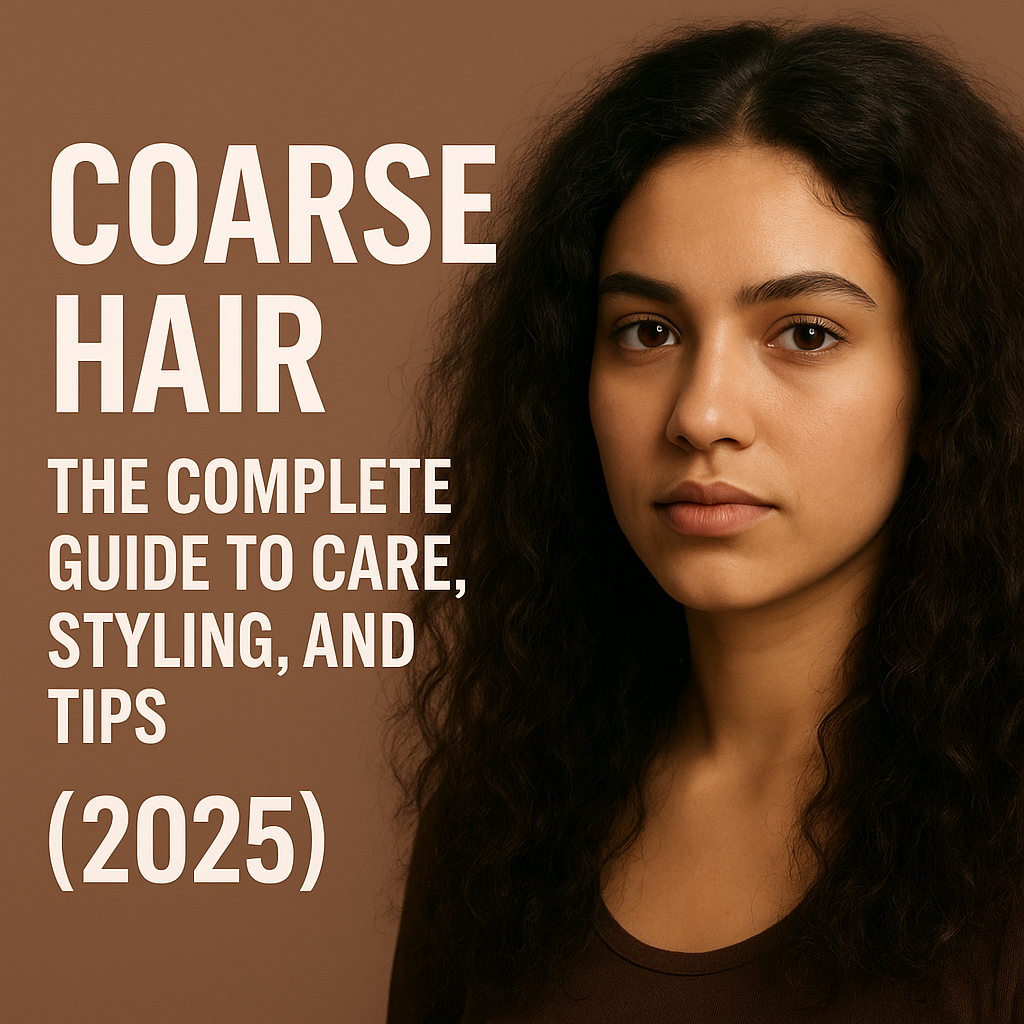
Pingback: Black and White Hair: Styles, Ideas & Tips for 2025 - nagashhealth